 |
 |
 |
| |
TLR9 AGONIST TRIGGERS POTENT INTESTINAL
ANTIVIRAL RESPONSE IN HIV+ INDIVIDUALS ON ART
|
| |
| |
Reported by Jules Levin
CROI 2017 Feb 14-16 Seattle, WA
Astrid R. Krarup1; Mariane H. Schleimann1; Line K. Vibholm1; Mohamed Abdel-Mohsen2; Anders K. Dige3; Lars ostergaard1,4; Thomas Benfield5; Satish Pillai2; Ole S. Sogaard1,4; Paul W. Denton1,4
1Department of Infectious Diseases, Aarhus University Hospital, Skejby, Denmark. 2Blood Systems Research Institute and University of California San Francisco, United States of America. 3Department of Hepatology and Gastroenterology, Aarhus University Hospital, Aarhus, Denmark.
4Department of Clinical Medicine, Aarhus University, Denmark. 5Department of Infectious Diseases, Copenhagen University Hospital, Hvidovre, Denmark.
Additional contributors not included in the published abstract: Jorgen Agnholt4,6; Xutao Deng2; Phillip A. Engen7; Stefan J. Green8,9; Ali Keshavarzian7; Alan Landay10; Ankur Naqib9; Jens Randel Nyengaard4,11; Rikke Olesen1; Andreas Munk Petersen12; Thomas A Rasmussen1; Martin Tolstrup1,4; Burghardt Wittig13
6Department of Hepatology and Gastroenterology, Aarhus University Hospital, Aarhus, Denmark. 7Department of Internal Medicine, Division of Gastroenterology, Rush University Medical Center, Chicago, IL USA. 8Department of Biological Sciences, University of Illinois at Chicago, Chicago, IL USA. 9DNA Services Facility, Research Resources Center, University of Illinois at Chicago, Chicago, IL USA. 10Department of
Immunology and Microbiology, Allergy/Immunology Section, Rush University Medical Center, Chicago, IL USA. 11Stereology and Electron Microscopy Laboratory, Aarhus University Hospital, Aarhus, Denmark. 12Department of Gastroenterology, Hvidovre Hospital, University of Copenhagen; Denmark. 13Foundation Institute Molecular Biology and Bioinformatics, Freie Universitaet Berlin, Germany

Abstract Body:
HIV persists in infected individuals despite ART. While persistent HIV becomes transcriptionally active in the presence of latency reversing agents, these agents have little effect on the size of the viral reservoir in vivo. Thus, improved killing of infected cells is essential to achieve viral eradication. Towards this goal, we tested whether a TLR9 agonist (MGN1703; lefitolimod) could enhance antiviral immunity in vivo.
Sigmoid biopsies were collected from 11 participants at baseline and 24 hours after the last dose in week 4 of a single-arm phase 1b/2a clinical trial where HIV+ adults received MGN1703 (60 mg s.c.) twice weekly for 4 weeks (NCT02443935). We quantitated IHC signal positive cell profiles (nucleus with associated signal; referred to as cells below) in fixed tissue sections for the antiviral and inflammatory response markers MxA, ISG15, IL-21, CXCL10 or MPO; data were stratified by anatomical location: lamina propria (LP) or epithelium. Remaining biopsy tissue was digested and percoll-enriched intestinal mononuclear cells were obtained for virological and immunological analyses [RNA-seq; HIV DNA/RNA levels (qPCR); CD4/CD8 T cell frequency and activation (flow)]. Plasma viremia quantitation: Cobas Taqman. Data analyses: Wilcoxon signed rank tests, mean fold change (mfc) and Ingenuity Pathway Analysis right-tailed Fisher Exact Test.
RNASeq revealed 248 significantly regulated genes (FDR<0.05) and a potent antiviral response (IPA p=2*10^-14) including many IFN-a stimulated genes. Indeed, MGN1703 dosing increased the number of cells positive for MxA (LP: p=0.001, mfc=8.8; and epithelium: p=0.003, mfc=27.6), ISG15 (LP: p=0.014, mfc=5.6) and IL-21 (LP: p=0.019, mfc=0.5). In contrast, there was no change in the numbers of cells positive for CXCL10 which is IFN-g induced (LP: p=0.97). No cohort-wide changes were observed in: neutrophil infiltration (MPO LP: p=0.97); viral DNA; viral RNA; T cell subset distribution; or T cell activation. However, after stratifying according to MGN1703-induced plasma viremia status, we observed that viremic individuals had a de crease (n=3, mfc=-0.8) in integrated intestinal lymphoid tissue HIV DNA (p=0.042).
MGN1703 induced robust antiviral immune responses in the intestines of HIV+ individuals on ART. In addition, the observed lack of neutrophil infiltration suggests that MGN1703 does not cause destructive tissue inflammation. These data support a prominent role for MGN1703 immunotherapy in HIV eradication strategies.

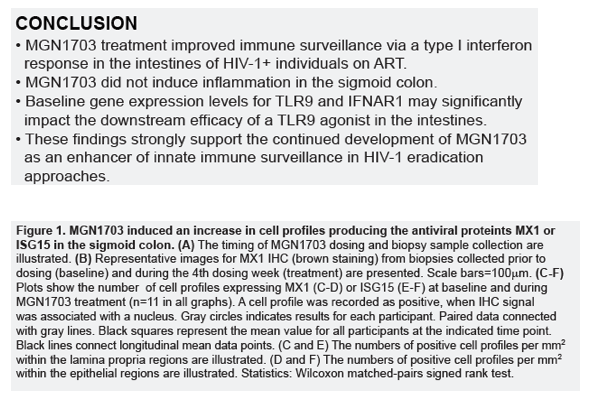
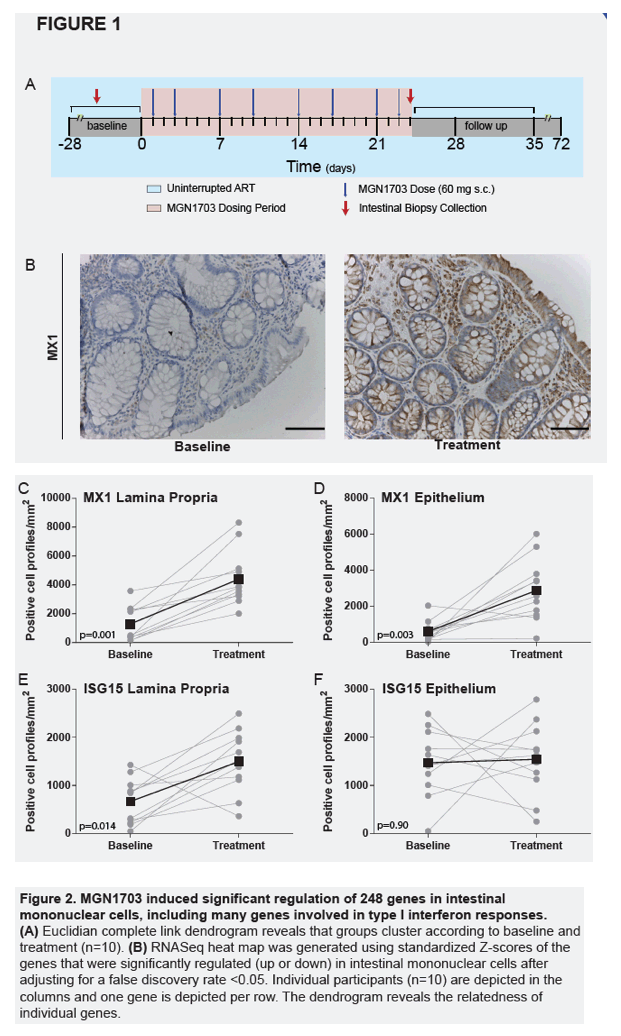
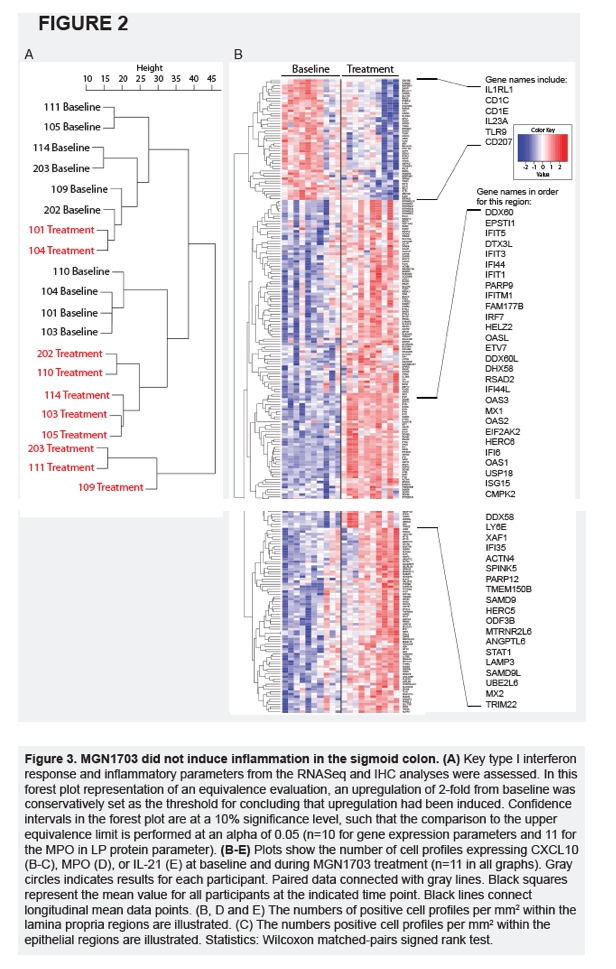
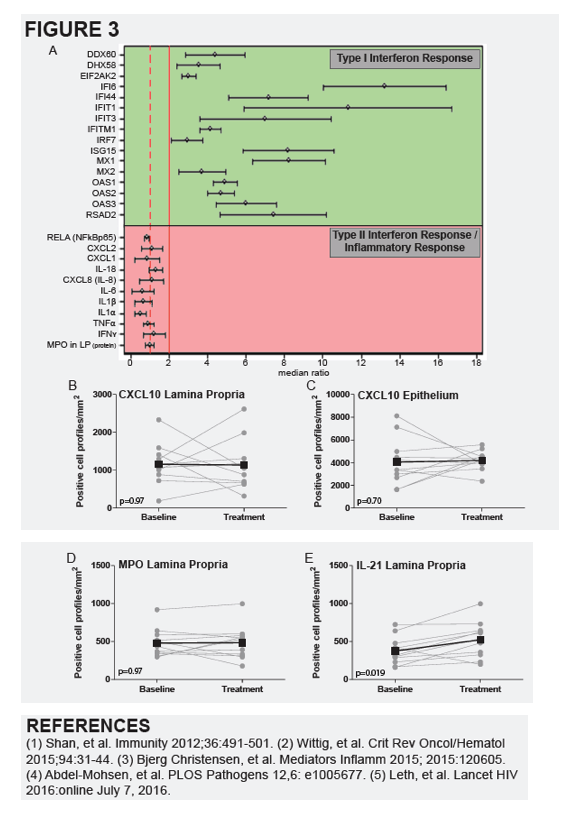
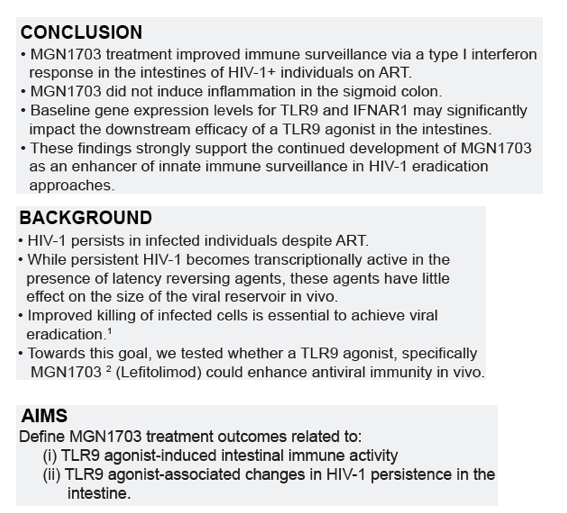
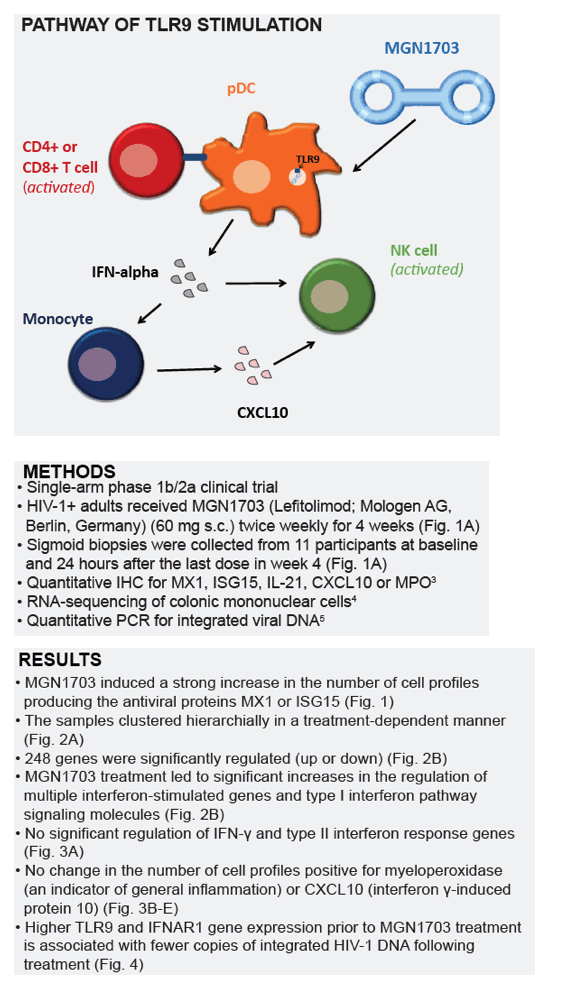
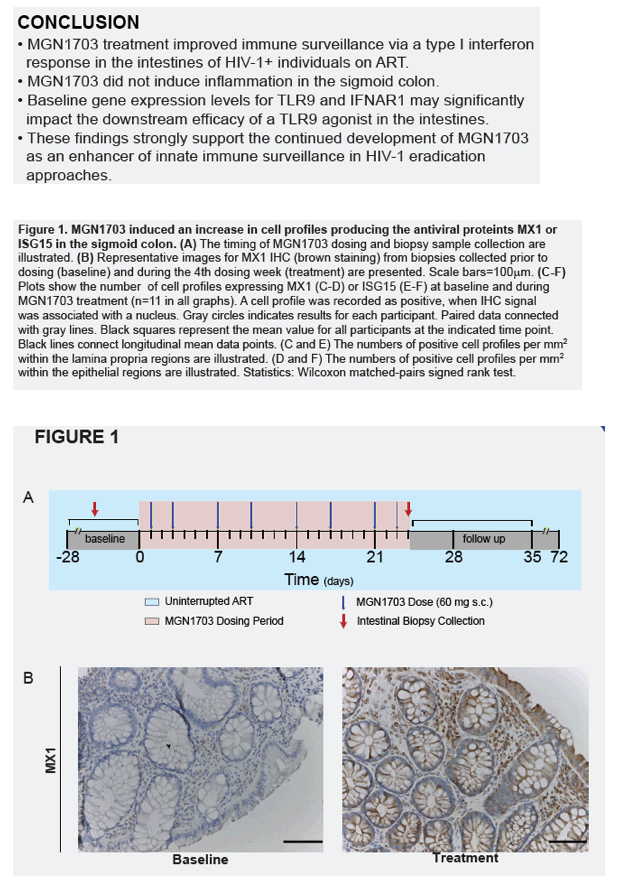
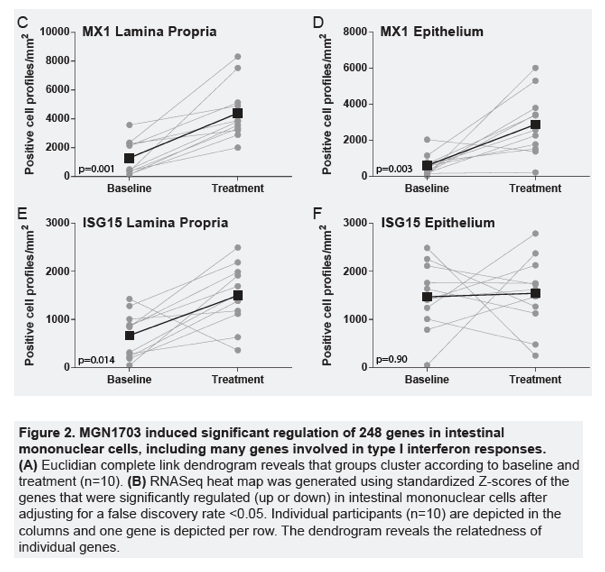
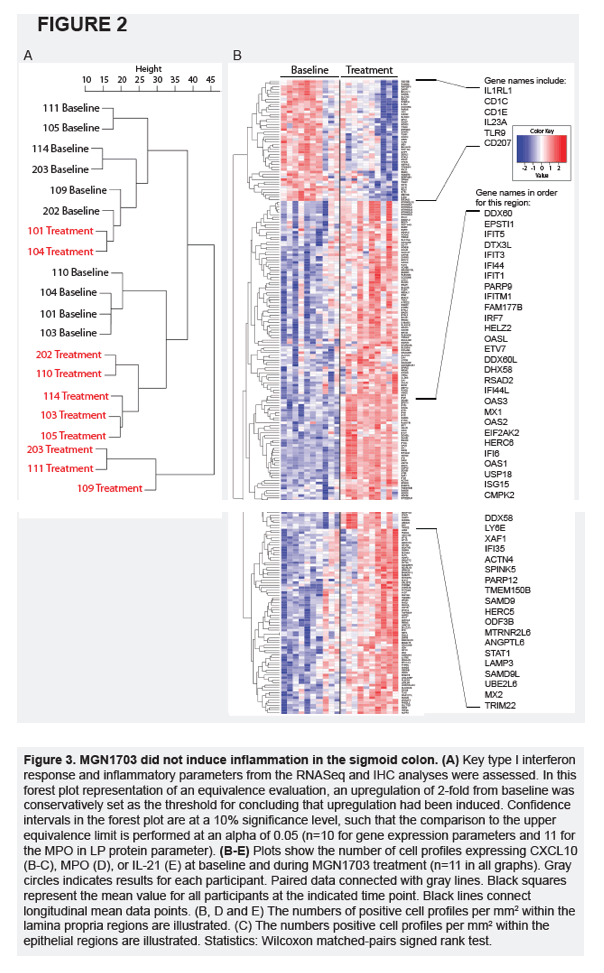
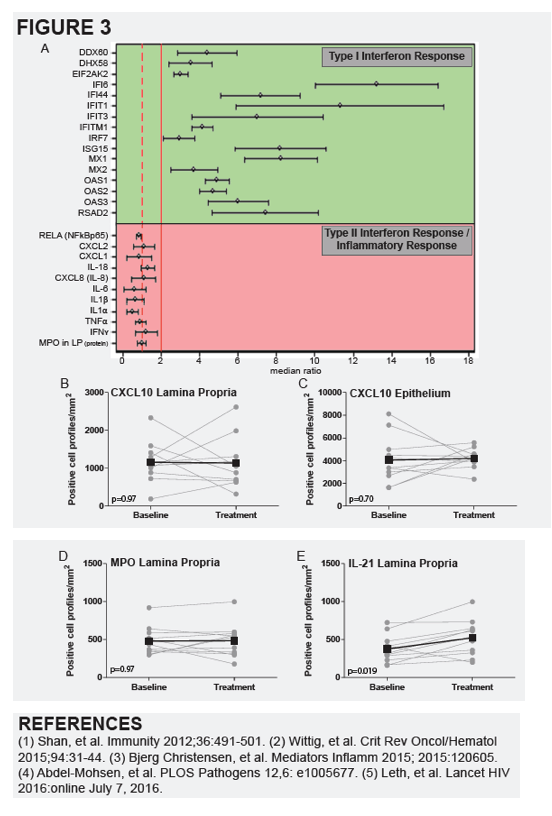
|
| |
|
 |
 |
|
|